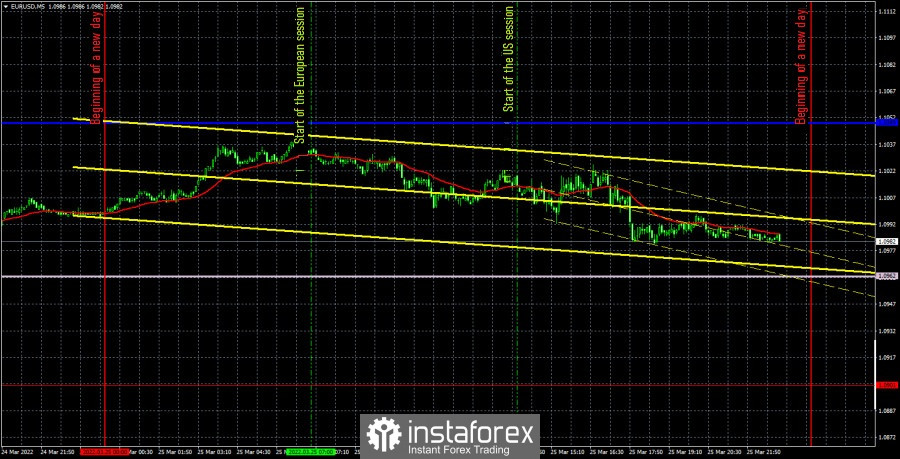

The EUR/USD pair continued to be flat last Friday. This is clearly visible on the hourly TF, where the price continues to be located between the critical line and the Senkou Span B line, the location of which we have not specifically changed in recent days so that they embody the horizontal channel. The pair is located in this horizontal channel at this time. We have already said earlier that after a month of fairly active trading, now may be the time to take a little break. All the most important and interesting events that traders were looking forward to were left behind, and on Friday there was not a single important macroeconomic event at all. It is unlikely that in the current conditions it was possible to count on the reaction of traders to the consumer sentiment index from the University of Michigan. Thus, at this time, the pair is quite reasonably inside the horizontal channel.
As for trading signals on Friday, everything is very simple here: not a single trading signal was formed during the day. The price did not even try to approach the Senkou Span B or Kijun-sen lines, so even theoretically there was no possibility for signal formation. From our point of view, this is for the best, since the movement has been sideways for most of the past week. There were relatively trending movements within the day, but at the same time, volatility decreased, and movements became more complex. Now the pair can continue to move in a limited range for some time.
COT report:
In the last two months, Commitment of Traders (COT) reports have signaled such changes in the mood of traders, which absolutely did not correspond to what was actually happening in the foreign exchange market. However, in the last two weeks, COT reports have at least begun to coincide a little with what is happening in the foreign exchange market. The major players in the last reporting week greatly reduced their net position, thanks to the meetings of the European Central Bank and the Federal Reserve, the results of which were very eloquent. This week, professional traders opened 5,000 long positions and closed 38 short positions. That is, the net position has increased by 5,000 contracts. Formally, the bullish mood, which remains exactly bullish, has slightly intensified. But look at the chart of the pair's movement in the chart above: the euro does nothing but fall. In this way, the euro is now only capable of local technical corrections. Fundamental and geopolitical factors have a huge impact on the market, so we do not believe that traders now have a reason to buy the euro currency. Therefore, the non-commercial group of traders can buy euros, sell euros, all the same, with the current foundation and geopolitics, the US dollar will grow. This is due to the fact that the COT report on the euro currency does not take into account changes in demand for the dollar itself. That is, it is reasonable to assume that the demand for the US currency is growing at a faster pace than the demand for the EU currency.
We recommend to familiarize yourself with:Overview of the EUR/USD pair. March 28. New week: European inflation, US Nonfarm.
Overview of the GBP/USD pair. March 28. The British pound is stuck in one place. Is the market waiting for new geopolitical events?
Forecast and trading signals for GBP/USD on March 28. Detailed analysis of the movement of the pair and trading transactions.
EUR/USD 1HBoth trend lines have already been canceled on the hourly timeframe, and the pair has gone flat. In principle, we warned about this: even if the downward trend line is overcome, the critical line will be more important. As you can see, the bulls failed to settle above it, so even overcoming the trend line did not add positive prospects to the European currency. Therefore, the main value now is the horizontal channel at 1.0962-1.1049. We can only expect a new trend to form if the price leaves this area. We allocate the following levels for trading on Monday - 1.0806, 1.0901, 1.1122, 1.1234, as well as the Senkou Span B (1.0962) and Kijun-sen (1.1049) lines. There are also support and resistance levels, but no signals will be formed near them. Signals can be "bounces" and "breakthrough" levels - extremes and lines. Do not forget about placing a Stop Loss order at breakeven if the price went in the right direction of 15 points. This will protect you against possible losses if the signal turns out to be false. The calendars of macroeconomic events in the United States and the European Union are completely empty on Monday. Thus, the probability that the pair will leave the horizontal channel, which we discussed above, today, is negligible. Of course, never say "never", but still there are no good reasons for a strong trend movement on Monday.
Explanations for the chart:Support and Resistance Levels are the levels that serve as targets when buying or selling the pair. You can place Take Profit near these levels.
Kijun-sen and Senkou Span B lines are lines of the Ichimoku indicator transferred to the hourly timeframe from the 4-hour one.
Support and resistance areas are areas from which the price has repeatedly rebounded off.
Yellow lines are trend lines, trend channels and any other technical patterns.
Indicator 1 on the COT charts is the size of the net position of each category of traders.
Indicator 2 on the COT charts is the size of the net position for the non-commercial group.